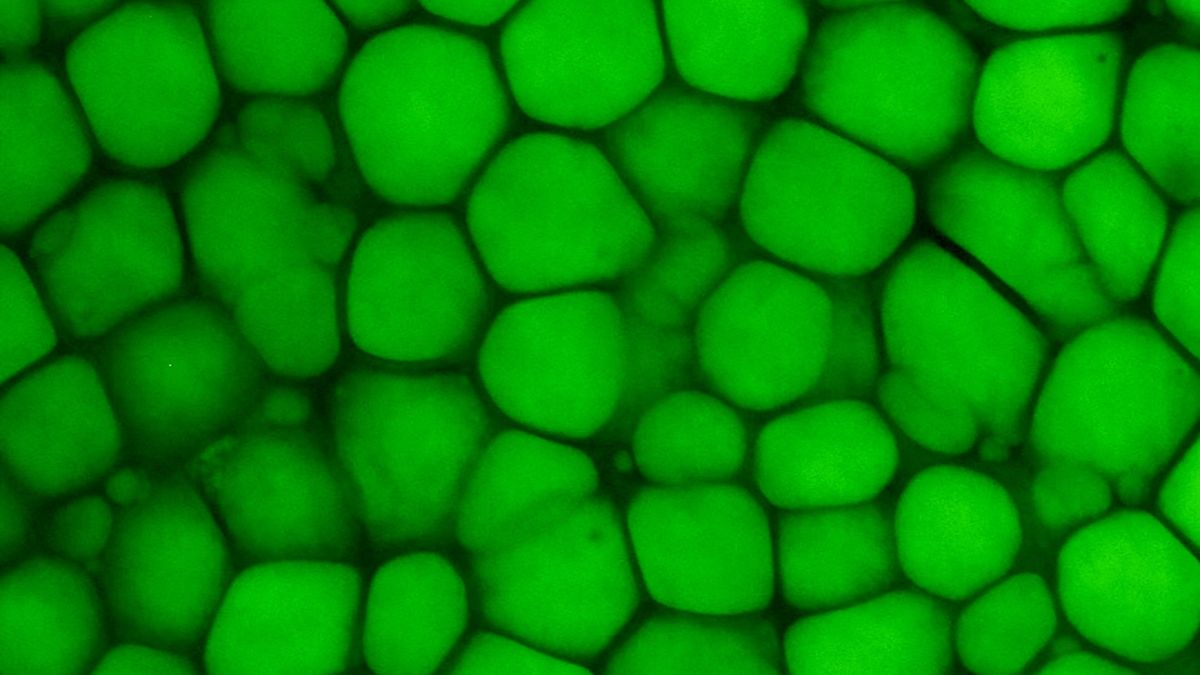:focal(576x433:577x434)/https://tf-cmsv2-smithsonianmag-media.s3.amazonaws.com/filer_public/6f/3c/6f3cb31e-236f-4648-ab6f-0d9b4f717471/main_zombie-flies-500x288.jpg)
The white substance on this fly is a fungus called Entomophthora muscae.
Filippo Castellucci
A fly is going about its day, buzzing here, buzzing there—but then, it starts behaving weirdly. Its movements become sluggish; its abdomen swells. Its body sprouts white fuzz.
Around sunset, there’s a sudden a burst of movement as the fly climbs—or “summits”—to an elevated location, like the top of a small plant or a stick, and extends its mouthparts. It spews out a sticky ooze that attaches it firmly to its perch—then it lifts up its wings and dies.
Down below, other unsuspecting flies are hit by a shower of white spores shooting out of the dead fly’s corpse. And the cycle starts all over.
The white stuff that engulfs these flies is a fungus called Entomophthora muscae—Entomophthora translates to “destroyer of insects.” It’s an obligate pathogen, entirely dependent on its host, that infects flies and turns them into “zombies” that execute its will.
Discovered more than 160 years ago, the fungus’s actions are as mind-boggling as they are macabre. Scientists have long wondered: How does the fungus manage to control the fly’s brain? How does it “know” to do it at a specific time of day? What genes within its genome help it to become a master manipulator?
Today, a flurry of experiments is starting to unravel the science behind this eerie mind control.
Fatal necrophilia
Henrik H. De Fine Licht, an evolutionary biologist at the University of Copenhagen, is one of the few people in the world working with “zombie” houseflies, Musca domestica. Though initially drawn to the fungus E. muscae because he wanted to study obligate pathogens, “I was, of course, also fascinated by the behavioral manipulation aspects and how that works,” he says.
Those details are like fodder for a horror movie. After the fungus infects the fly, it doesn’t go straight to the vital organs but starts consuming fats and other nutrients first, gradually starving the fly but keeping it alive. Only when it runs out of non-vital organs to chomp on does it start to control the fly’s behavior, thus ensuring its continuity: By forcing the fly to seek some height and get stuck there, it ensures wide distribution of its spores.
Life cycle of the fungus Entomophthora muscae Adapted from H.H. De Fine Licht et al. / Authorea 2023 (preprint) / Knowable Magazine/https://tf-cmsv2-smithsonianmag-media.s3.amazonaws.com/filer_public/64/21/6421b594-e8e7-4d4c-a7aa-b22802f6e184/1_g-zombie-fly-life-cycle.jpg)
De Fine Licht was especially intrigued by reports describing how the fungus manipulates flies by making female fly carcasses attractive to healthy males. The males fly in and try to mate with the infected cadavers—and promptly get infected themselves. To delve into the nature of this fatal attraction, De Fine Licht and his team mashed up infected and uninfected fly carcasses to extract and analyze chemicals, and studied the air surrounding the cadavers. They reported in 2022 that the fungus releases volatile chemicals that lure the males in.
It isn’t fully clear, though, whether the volatiles are attracting male flies with the promise of sex or of nutrition, De Fine Licht says. A working hypothesis is that they might just be attracted because they think it is food. “But when they come in close proximity, they start to smell some less-volatile compounds of the cadavers—and that is eliciting the sexual behavior,” he says
Annette Jensen, an organismal biologist at the University of Copenhagen, also noticed something intriguing about how other insects reacted to the dead flies’ odor. She and one of her students found that the earwig—an insect that feeds on other insects—is drawn to the sporulating fly cadavers infected by E. muscae and prefers to feed on them over uninfected cadavers or cadavers infected with other kinds of fungi. The scientists reached their conclusions after conducting experiments in which earwigs were placed between two types of cadavers and could select which one to move toward.
“There might be something with the volatiles from Entomophthora muscae that also attracts predators,” says Jensen, who co-wrote an overview on fungi that are pathogenic to insects in the Annual Review of Entomology. “It’s probably super nutritious!”
E. muscae-infected female cadavers emit volatile chemicals that lure unsuspecting male flies. The males try to mate with the female corpses, becoming infected in the process. In this image, two male flies were attracted to the scent. Filippo Castellucci/https://tf-cmsv2-smithsonianmag-media.s3.amazonaws.com/filer_public/40/b4/40b48e43-b95a-43a0-9d9a-2a65306e7862/2_p-fly-mate-infected-cadaver.jpg)
Fruit flies join the victims list
Most zombie fly work has focused on houseflies, but Harvard University molecular biologist and zombiologist Carolyn Elya set her research sights on fruit flies after serendipitously discovering some zombified ones in her backyard when she was a PhD student at the University of California, Berkeley. She had put out rotten fruit as bait for capturing wild fruit flies for experiments and was surprised to see some dead ones with their wings up in that telltale pose, with white, fuzzy spores on their abdomens. She quickly sequenced some DNA from the spores and confirmed her hunch: These fruit flies were victims of E. muscae.
Elya went on to infect Drosophila melanogaster, a well-established lab model that researchers around the world have studied for over a century. With this E. muscae-D. melanogaster system, she is keen to leverage the powerful Drosophila genetic toolkit and study the fly brain to understand how the fungus carries out its manipulation.
In a 2023 report, Elya and her coworkers showed that the fungus could be secreting something into the fly’s “blood”—its hemolymph—that helps to manipulate fly neurons. When she injected the hemolymph from infected flies into uninfected ones, the latter started behaving as though they had been zombified.
Elya also discovered that the fly’s circadian neurons—the ones that help it keep track of daily rhythms—may be involved in the time-sensitive height-seeking behavior. Silencing specific sets of these neurons in the brain inhibited summiting activity in the infected flies.
E. muscae-infected “zombie” Drosophila fruit flies behave similarly to houseflies. This photo shows them climbing to the top of a stick and adhering themselves onto it with their mouthparts. They also lift their wings up before dying, ensuring that the spores will be well distributed. Carolyn Elya/https://tf-cmsv2-smithsonianmag-media.s3.amazonaws.com/filer_public/b0/df/b0df037b-a00d-4e93-949b-6f87f58b7b88/3_p-killed-fruit-flies-dowel.jpg)
Elya also wants to understand this mind control from the fungus’s perspective—and to that end, she, De Fine Licht and others recently sequenced the huge E. muscae genome. Focusing on the strain that infects fruit flies, the scientists reported finding genes similar to one called “white-collar 1,” which carries instructions for making a blue-light sensor in a mold called Neurospora crassa. In N. crassa, white-collar 1 plays a role in circadian rhythms—and so the scientists hypothesize that this gene might be involved in driving the precise timing of infected flies’ summiting behavior around sunset, followed by their death.
The scientists also discovered a lot of genes that could help the fungus make full use of the fly’s tissues and nutrients. These included specialized genes that code for trehalase enzymes, which digest trehalose, the primary sugar in hemolymph; for proteins like chitinases that break down chitin in the fly’s exoskeleton; and for lipases, which break down fats.
“That makes sense, right? Because these fungi are very specialized in the way that they utilize their hosts—not by killing them first and then eating them later, which is a strategy that’s used by a lot of generalist pathogens—but instead they grow inside of the insects,” Elya says. “Being able to specifically target every last tissue in their host is important.”
And the quest for more clues continues, with researchers moving beyond the static genome to study the RNA copies of genes that are made when specific genes are active. In a research paper that has yet to be peer-reviewed, Sam Edwards, a postdoctoral researcher at Wageningen University in the Netherlands; De Fine Licht; and colleagues reported their analysis of the RNA in housefly heads at different time points after an E. muscae infection. By figuring out which fly and fungus genes were active inside the fly’s head, they hoped to get a glimpse at how the fungus manipulates the fly’s behavior.
The team detected activity of a fungal gene that is similar to one called ecdysteroid UDP-glucosyltransferase, or “egt,” that is present in certain zombifying viruses. These viruses, like E. muscae, force their infected victims—in this case, caterpillars—to move to high locations, and in a move more gruesome than that of their fungal counterparts, cause the caterpillars to melt and release the viral particles below. The egt gene plays a role in this virus-induced caterpillar summitting behavior, so the researchers now want to know whether the gene in E. muscae is key to inducing summitting in infected flies.
In a further twist, both De Fine Licht’s preprint and a recent University of California, Berkeley, study that Elya co-wrote find that E. muscae may not be operating alone. The fungus appears to be infected by a virus at the same time as it’s parasitizing houseflies and fruit flies. Whether this virus helps the fungus control the fly, though, remains to be seen.
Elya, De Fine Licht and others all still want to know how the fungus begins its manipulation. One hypothesis is that E. muscae directly releases a chemical that activates the neurons involved in the fly’s summitting behavior. But another hypothesis is that the fungus’s all-consuming presence, and the consequent physiological changes in the fly, trigger the fly’s own neurons to release chemicals to kick-start the process.
De Fine Licht is keen for the zombie fly-fungus system to be taught in schools, to draw in younger science enthusiasts. He and Edwards recently published instructions on how to observe the zombifying fungus in the lab. “It could encourage high school teachers and others to try this out, if they wanted to,” De Fine Licht says.
Some of this involves collecting fly cadavers from the field and isolating the fungus from them.
“Or you could try to infect some healthy flies in the laboratory by putting them together with the cadaver,” De Fine Licht says. “That might be the most fun, right? Trying to observe the zombie behavior in a tiny little box.”

Knowable Magazine is an independent journalistic endeavor from Annual Reviews.







Leave a Comment